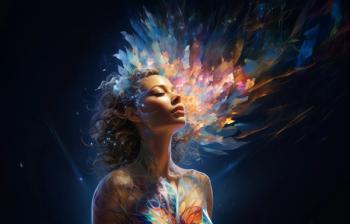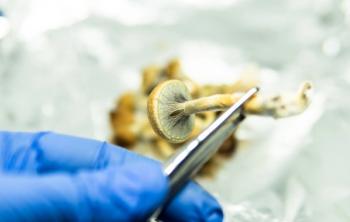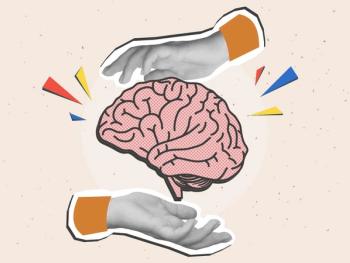
- Volume 39, Issue 9 Psychedelics Supplement
Interest Grows in Treatment of Mood Disorders by Classic Psychedelics
Classic psychedelic research is rapidly expanding...
There is a buzz surrounding the potential use of psychedelic drugs as novel treatments in mental health—both for the public and within the scientific community. Although this buzz may be akin to a similar, less regulated boom that occurred in the 1950s and 1960s,
Classic psychedelics induce altered states of consciousness that are experienced through visual effects, changes in perception, and distortions in sense of time and space. They can produce a sense of awe and connectedness, as well as personal insights and strong emotions. Research into classic serotonergic psychedelics began in the late 1930s when Albert Hofmann synthesized LSD for use as a cardiorespiratory stimulant only to accidentally ingest it and realize its psychotropic properties.4 This event, coupled with an article by R. Gordon Wasson in Life in 1957 entitled “Seeking the Magic Mushroom,” catapulted
Although this initial wave of psychedelic research would not hold up to the rigorous scientific methods and ethical policies of today, it has helped inform the development of present-day trials, both positively and negatively. Current protocols involve intensive screening procedures followed by several hours of psychological support provided before, during, and after the dosing session(s). Psychedelic research has increased exponentially over the past 10 years (
Depression
More recently, several clinical trials have demonstrated positive response and remission rates for intravenous and intranasal
Mechanism of Action
Depression is characterized by negativity bias, rigid thought patterns, rumination, and cognitive inflexibility. The brain’s default mode network (DMN)—made up of the ventromedial prefrontal cortex, the perigenual anterior cingulate cortex, and the posterior cingulate cortex—is involved in introspection and self-referential thinking. Altered activity, specifically overactivity, of the DMN has been demonstrated in depression10,11 in addition to hypoconnectivity with other higher- order cognitive networks such as the executive network and the salience network.12,13
Although there is some debate in the field, it is believed that classic psychedelics may exert their effects—at least in part—by disrupting activity in these networks.14,15 Evidence from ayahuasca and psilocybin imaging studies has demonstrated decreases in activity in key regions of the DMN.16-18 Connectivity alterations may also be strengthened by the promotion of structural and functional neuronal plasticity.19 Taken together, it is theorized that classic psychedelics exert their effects through differential changes in connectivity, which can result in increased cognitive flexibility and disruptions to maladaptive patterns of thoughts and behavior.
Clinical Trials
Several trials investigating the use of psilocybin for major depression have been conducted using open-label or wait-list controlled designs.20,21 Results were promising, with rapid and significant antidepressant effects 1 week20,21 post treatment that were largely sustained at follow-up periods of 3,20,22-23 6,22,23 and 12 months22; a study found that 58% of participants maintained remission at 12 months.22 Likewise, trials have been conducted in patients in end-of-life care who are experiencing
More recently, a phase 2, double-blind, randomized, controlled trial of escitalopram vs psilocybin-assisted therapy for major depressive disorder (MDD) was conducted.26 Participants randomized to the psilocybin group had 2 dosing sessions separated by 3 weeks, where they received 1 dose of 25 mg of psilocybin at each session and were given placebo pills to take between treatments. Participants in the escitalopram group received 10 to 20 mg of escitalopram administered over 6 weeks. All participants had moderate to severe depression at baseline (mean scores of 14.5 in the psilocybin group and 16.4 in the escitalopram group, as determined by the Quick Inventory of Depressive Symptomatology Self-Report [QIDS-SR-16]).
At the 6-week follow-up, participants in both groups had lower QIDS-SR scores compared with baseline, but the scores did not significantly differ between the escitalopram and
Psilocybin is not the only serotonergic psychedelic being investigated as a potential treatment for depression. The “vine of the souls” plant traditionally found in South America and commonly known as ayahuasca has also demonstrated antidepressant properties in clinical and nonclinical trials.27-29 In one randomized, controlled trial, patients with treatment-resistant depression who were given a single dose of ayahuasca had significantly lower MADRS scores compared with the placebo group at day 1 (P = .04), day 2 (P = .004), and day 7 (P = .0001) post dose.28 Likewise, 5-methoxy-N,N-dimethyltryptamine (5-MeO-DMT), a potent, short-acting psychedelic, and LSD, a serotonergic and dopaminergic partial agonist, have ongoing or completed clinical trials investigating their therapeutic benefits for depression (
Although this evidence demonstrates positive results, the data on efficacy and safety of psychedelics in the treatment of MDD are preliminary and should be considered in the context of several challenges facing the field.29
Ethical Considerations
It appears that research into the therapeutic effects of serotonergic psychedelics will grow in the coming years. As more data become available, establishing clear guidelines for psychedelic-assisted psychotherapy (PAP) will be important. Discussions regarding therapist training, burden of cost, accessibility, and participant safety are needed. Psychedelic therapy is resource intensive and necessitates several hours of specialized therapy. Innovative study protocols aimed at reducing cost and resource burdens will be important in facilitating this research into clinical practice, especially in underresourced communities.
Recent studies have found serious AEs to be rare if proper screening, monitoring, and safety protocols are in place. However, increasing attention to these drugs suggests that investigators need to be cautiously aware of how results of clinical trials are communicated to the public. Transparency regarding AEs, rigorous reviews of study data, and critiques from the scientific community should not be overshadowed by positive results.
Expectancy effects also require consideration—previous experience using psychedelics and enthusiasm in the media may predispose study participants to expect positive
Investigators should also pay special attention to informed consent. It can be difficult to fully prepare someone for a psychedelic experience; it necessitates a thorough consent and preparatory process in which participant boundaries (eg, hand-holding when feeling distressed during the dosing sessions) are established in advance of treatment.
Finally, more research needs to be conducted in participants with diverse ethnic and socioeconomic backgrounds. To date, most studies investigating PAP have been conducted in North America and western Europe with patient cohorts being predominantly white.30 Study samples more representative of the general population need to be a focus in future work.
Future Research
Psychedelic research is expanding into other areas of psychiatry including
There has also been a large expansion into addictions research (eg, cocaine, alcohol, opioids). Although psilocybin remains the most-studied agent in substance use disorders, ibogaine is also receiving attention. Ibogaine is an indole alkaloid with dissociative properties that may exert therapeutic benefit for substance use disorders by reducing drug cravings, improving mood, and preventing withdrawal symptoms. Promising case reports and open-label trials in opioid addiction have demonstrated elimination of withdrawal symptoms and anticraving capacities following ibogaine administration.34-37 There are 3 ongoing trials registered in Spain, Brazil, and the United States to investigate ibogaine treatment in methadone detoxification, opioid withdrawal, and
Concluding Thoughts
Classic psychedelic research is rapidly expanding, and preliminary evidence demonstrates therapeutic potential especially for the treatment of major depression and end-of-life distress. However, the field is facing several ethical and methodological challenges that need to be addressed. Larger, well-designed prospective trials are needed to confirm preliminary evidence for the therapeutic actions of psychedelics in individuals with mood and anxiety disorders, including depression and OCD.
Ms Ledwos is research coordinator for psychedelic studies in the Centre for Complex Interventions (CCI) at the Centre for Addiction and Mental Health (CAMH) in Canada. Dr Husain is a clinician scientist and lead of the Mood Disorders Service at CAMH, and associate professor of psychiatry at the University of Toronto in Canada. Dr Castle is scientific director of the CCI at CAMH and professor of psychiatry at the University of Toronto. Dr George is a professor of psychiatry at the University of Toronto and a clinician-scientist at CAMH. He is also a member of the Editorial Board at Psychiatric Times™, and incoming coprincipal editor of Neuropsychopharmacology, the journal of the American College of Neuropsychopharmacology.
References
1. Samorini G. The oldest representations of hallucinogenic mushrooms in the world (Sahara Desert, 9000-7000 BP). Semantic Scholar. 2016. Accessed June 20, 2022.
2. Adovasio JM, Fry GF.
3. Halberstadt AL.
4. Hofmann A. LSD: My Problem Child. McGraw-Hill Book Company; 1980.
5. Phelps J, Shah RN, Lieberman JA.
6. Ferrari AJ, Charlson FJ, Norman RE, et al.
7. Tang F, Liang J, Zhang H, et al.
8. Bahji A, Vazquez GH, Zarate CA Jr.
9. Rosenblat JD, Ishrat MH, Lee Y, et al.
10. Hamilton JP, Furman DJ, Chang C, et al.
11. Sheline YI, Barch DM, Price JL, et al.
12. Goodman ZT, Bainter SA, Kornfeld S, Chang C, Nomi JS, Uddin LQ.
13. Lydon-Staley DM, Kuehner C, Zamoscik V, et al.
14. Smigielski L, Scheidegger M, Kometer M, Vollenweider FX.
15. Pasquini L, Palhano-Fontes F, Araujo DB.
16. Daws RE, Timmermann C, Giribaldi B, et al.
17. Palhano-Fontes F, Andrade KC, Tofoli LF, et al.
18. Carhart-Harris RL, Erritzoe D, Williams T, et al.
19. Ly C, Greb AC, Cameron LP, et al.
20. Carhart-Harris RL, Bolstridge M, Rucker J, et al.
21. Davis AK, Barrett FS, May DG, et al.
22. Gukasyan N, Davis AK, Barrett FS, et al.
23. Carhart-Harris RL, Bolstridge M, Day CMJ, et al.
24. Griffiths RR, Johnson MW, Carducci MA, et al.
25. Ross S, Bossis A, Guss J, et al.
26. Carhart-Harris R, Giribaldi B, Watts R, et al.
27. Osório Fde L, Sanches RF, Macedo LR, et al.
28. Palhano-Fontes F, Barreto D, Onias H, et al.
29. Sanches RF, de Lima Osório F, Dos Santos RG, et al.
30. Fogg C, Michaels TI, de la Salle S, et al.
31. Lafrance A, Loizaga-Velder A, Fletcher J, et al.
32. Renelli M, Fletcher J, Tupper KW, et al.
33. Moreno FA, Wiegand CB, Taitano EK, Delgado PL.
34. Alper KR, Lotsof HS, Frenken GM, et al.
35. Brown TK, Alper K.
36. Davis AK, Barsuglia JP, Windham-Herman AM, et al.
37. Noller GE, Frampton CM, Yazar-Klosinski B.
Articles in this issue
over 3 years ago
Effects of LSD and Psilocybin in Healthy Participantsover 3 years ago
Challenging the Status Quo of the Challenge to the Status Quoover 3 years ago
Numinus ResourcesNewsletter
Receive trusted psychiatric news, expert analysis, and clinical insights — subscribe today to support your practice and your patients.

















